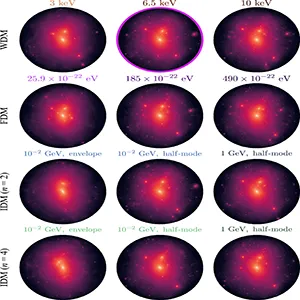
Digital clones of our Milky Way created using strange physics laws to study 'alternate' versions of the universe
You can’t see it, yet it tugs on every star in the sky. Astronomers call this hidden glue dark matter, and for nearly a century they have struggled to learn what it is and how it shapes the Milky Way.
The newest clue comes from a Hollywood‑scale digital stunt double of our own galaxy called the COZMIC suite.
Led by USC cosmologist Vera Gluscevic, the project runs on a supercomputer that rewinds cosmic history and plays it back under different laws of physics.
COZMIC clones of the Milky Way
Each COZMIC (COZMIC I, COZMIC II, and COZMIC III) run starts with the same early‑universe snapshot but tweaks the way invisible particles behave.
Instead of a single answer, the team produced 72 high‑resolution twins, letting them grow for 13.8 billion years until they matched the size of today’s Milky Way.
The calculations run on hundreds of graphics processing units, each crunching trillions of math operations per second.
Over several weeks the code follows billions of dark particles and millions of star‑forming gas parcels, storing snapshots that would fill a stack of laptops.
“With COZMIC, for the first time, we’re able to simulate galaxies like our own under radically different physical laws, and test those laws against real astronomical observations,” said Gluscevic, in the first installment of the project, COZMIC I.
Those digital galaxies contain familiar spiral arms plus a halo of invisible mass.
Yet their satellite populations differ in striking ways that reveal how the unseen particles may collide, stream, or even quantum‑wiggle through space.
3 dark matter behaviors in COZMIC
One set of simulations treats dark matter like billiard balls that smack into protons when the universe is young. Those early hits smooth out small clumps and erase many dwarf satellites that astronomers usually expect to see.
A second family mixes interactive and aloof particles, a hybrid that leaves some satellites intact while thinning others.
This “fractional” model appears in COZMIC II and maps out thresholds where warm‑style particles compose 50 percent or more of the cosmic budget.
The third scenario adds self‑interacting dark matter, letting invisible particles bump into one another as well as normal matter. That option, explored in COZMIC III, softens the dense cores of dwarf galaxies and delays their collapse.
“Our simulations reveal that observations of the smallest galaxies can be used to distinguish dark matter models,” noted Ethan Nadler, assistant professor at UC San Diego, in the second paper.
His point underscores why astronomers chase faint dwarfs with telescopes from Chile to Hawaii.
Small galaxies help reveal dark matter clues
A dwarf galaxy can pack only a few thousand stars, but its motion betrays a hefty halo of dark mass. Because these halos cooled first, they hold a memory of particle physics that larger systems have forgotten.
The team counted every subhalo (a dark clump orbiting the Milky Way twin) and built curves called the subhalo mass function.
Changing the interaction rules tilts that curve, offering an honest‑to‑goodness laboratory test once real counts from the Vera C. Rubin Observatory arrive.
Statisticians then compare the simulated subhalo catalog to real counts using Bayesian models, treating every faint satellite as a vote for or against a particular particle mass. The approach turns the night sky into a polling booth for fundamental physics.
Some types of dark matter are already ruled out by these simulations. Particles that are too light or too fuzzy don’t match what astronomers see. And if the particles interact too strongly, they erase too many small galaxies.
“While many previous simulation suites have explored the effects of dark matter mass or self‑interactions, until now, none have simulated dark matter interactions with normal matter,” added Andrew Benson, staff scientist at Carnegie Observatories, in the third paper.
Benson’s colleagues find that mixing both effects nearly eliminates the core‑collapse problem that once plagued self‑interacting models.
Testing ideas against the night sky
Digital predictions will soon crash into data from Gaia, Hubble, and the Nancy Grace Roman Space Telescope.
By matching satellite counts, stellar motions, and halo shapes, observers can rule out candidates with the stroke of a spectrograph.
The method recalls Swiss astronomer Fritz Zwicky, who in 1933 spotted missing mass in the Coma Cluster. Back then he had only pencil and paper; today’s teams wield petaflop machines and terabytes of star catalogs.

Each COZMIC twin keeps track of where dark matter went and how long structures took to form.
Those growth histories leave signatures in the ages of the oldest stars, the thickness of gaseous disks, and the timing of satellite mergers.
Future of cosmic cartography
Gluscevic’s group plans to stitch their virtual halos onto telescope images one field at a time. By ranking which simulation best reproduces reality, they can close in on the true behavior of the hidden particles.
“We’re finally able to ask, ‘Which version of the universe looks most like ours?'” Gluscevic said. The answer could narrow the menu of dark‑matter candidates or even tip the scales toward a brand‑new sector of physics.
Fresh runs are already queued on national supercomputers, with higher resolution and more exotic particle recipes. Meanwhile, observers are cataloging hundreds of ultra‑faint dwarfs that will serve as the ultimate judges.
Cracking the mystery will not happen overnight, but the Milky Way’s twin has handed researchers a cosmic magnifying glass.
Every tiny galaxy that turns up in the next sky survey will tighten the screws on theories that have survived for decades.
The studies are published in The Astrophysical Journal: COZMIC I, COZMIC II and COZMIC III
—–
Like what you read? Subscribe to our newsletter for engaging articles, exclusive content, and the latest updates.
Check us out on EarthSnap, a free app brought to you by Eric Ralls and Earth.com.
—–













